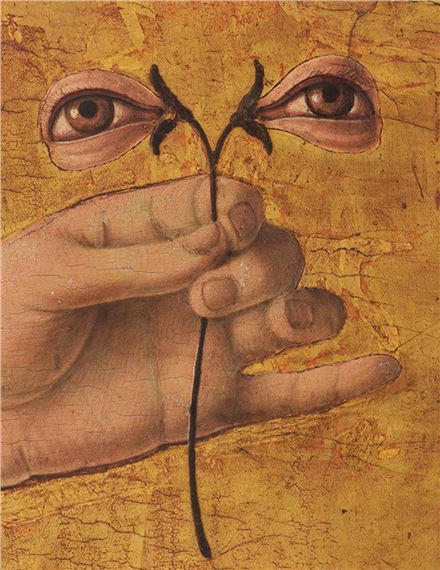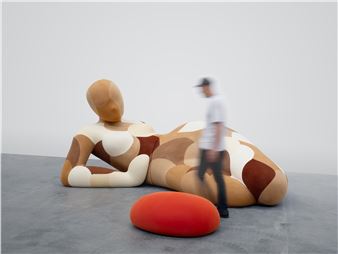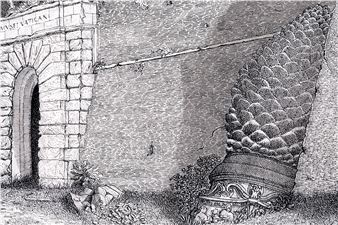PUPILS: When We Look At Each Other Our Eyes Blossom
The pupil is the opening at the centre of the iris through which rays of light pass to reach the crystalline lens. The word was originally a Latinism, a diminutive of pupa, i.e. doll, girl. When we look someone in the eye, the shiny black of the pupil reflects our own image, a tiny human figure. Which means that before the invention of mirrors, it was only possible to see ourselves in anotherвҖҷs gaze. This way of referring to what allows us to see is also to be found in ancient Greek. In fact the word kore is used to indicate both a girl and the pupil, setting the seal on a profound connection between these two concepts.
Kore, or the вҖҳunspeakable girlвҖҷ as Giorgio Agamben has defined this figure, a Greek myth that tells a story of the dark underworld but at the same time of radiant sunshine and that, given its intimate connection with the Eleusinian mysteries, was linked to silence (the term вҖҳmysteryвҖҷ comes from a root that means вҖҳto close the mouth, to keep silentвҖҷ).
The subtitle quotes the beginning of a poem by Else Lasker-SchГјler (1869-1945), in whose work the eyes are presented as the centre of consciousness and a meeting place of the soul and the visible world.
The exhibition explores some of the themes covered in Masaccio and Angelico: Dialogue on Truth in Painting, which is currently being staged at the Museo delle Terre Nuove and the Museo della Basilica. A dialogue that, in this case, is nourished by gazes, those of Mary and the Angel in the вҖҳAnnunciationsвҖҷ, and of the Madonna and Child, looking and being looked at, the pulsations of the gaze itself or the entry into the gaze of the other and вҖҳabandoning yourself to the angelвҖҷs callвҖҷ. In a correspondence of aesthetic and conceptual synergies, and making reference to the notions discussed above (gaze | pupil | kore | girl), Casa Masaccio orchestrates a dialogue on the gaze in which the concepts of the вҖңFeminineвҖқ pervade the exhibition, involving women artists of different generations inclined to representation of the body and its metaphors and metamorphosis, who on this specific occasion take on local history and art, selecting or producing works and interventions specifically for the occasion.

Recommended for you
The pupil is the opening at the centre of the iris through which rays of light pass to reach the crystalline lens. The word was originally a Latinism, a diminutive of pupa, i.e. doll, girl. When we look someone in the eye, the shiny black of the pupil reflects our own image, a tiny human figure. Which means that before the invention of mirrors, it was only possible to see ourselves in anotherвҖҷs gaze. This way of referring to what allows us to see is also to be found in ancient Greek. In fact the word kore is used to indicate both a girl and the pupil, setting the seal on a profound connection between these two concepts.
Kore, or the вҖҳunspeakable girlвҖҷ as Giorgio Agamben has defined this figure, a Greek myth that tells a story of the dark underworld but at the same time of radiant sunshine and that, given its intimate connection with the Eleusinian mysteries, was linked to silence (the term вҖҳmysteryвҖҷ comes from a root that means вҖҳto close the mouth, to keep silentвҖҷ).
The subtitle quotes the beginning of a poem by Else Lasker-SchГјler (1869-1945), in whose work the eyes are presented as the centre of consciousness and a meeting place of the soul and the visible world.
The exhibition explores some of the themes covered in Masaccio and Angelico: Dialogue on Truth in Painting, which is currently being staged at the Museo delle Terre Nuove and the Museo della Basilica. A dialogue that, in this case, is nourished by gazes, those of Mary and the Angel in the вҖҳAnnunciationsвҖҷ, and of the Madonna and Child, looking and being looked at, the pulsations of the gaze itself or the entry into the gaze of the other and вҖҳabandoning yourself to the angelвҖҷs callвҖҷ. In a correspondence of aesthetic and conceptual synergies, and making reference to the notions discussed above (gaze | pupil | kore | girl), Casa Masaccio orchestrates a dialogue on the gaze in which the concepts of the вҖңFeminineвҖқ pervade the exhibition, involving women artists of different generations inclined to representation of the body and its metaphors and metamorphosis, who on this specific occasion take on local history and art, selecting or producing works and interventions specifically for the occasion.

 ARTISTS
ARTISTS
















